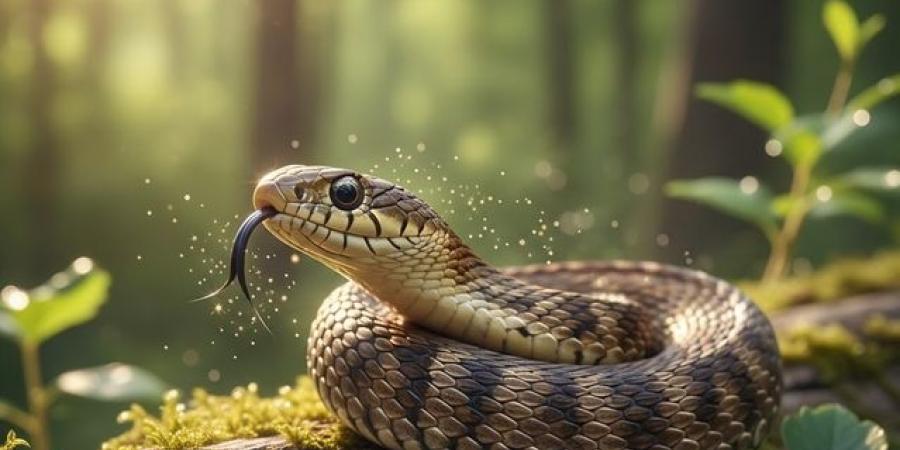نعرض لكم زوارنا أهم وأحدث الأخبار فى المقال الاتي:
Why Do Snakes Constantly Move Their Tongues? 8 reasons - المصدر 24, اليوم الأحد 16 نوفمبر 2025 10:55 صباحاً
المصدر 24 - If you’ve ever watched a snake closely, you’ve probably noticed one behavior that stands out:
It constantly flicks its tongue in and out — fast, rhythmic, and almost hypnotic.
This strange, signature movement often makes people uneasy, but in the world of reptiles, tongue-flicking is an extraordinary survival tool. Unlike humans and many animals, snakes depend heavily on their tongue to understand the world around them. Since they have poor eyesight and limited hearing, their tongue becomes a super-sensor — a biological device far more advanced than it looks.
Here is why snakes constantly move their tongues, what information they gather from each flick, and why this behavior is crucial for survival.
1. Snakes Use Their Tongue to “Smell” Their Environment
Snakes do not smell the same way humans do.
Instead, they use a powerful chemical detection system.
How it works:
Snakes collect chemical particles from the air or the ground by flicking their tongues.
They pull the tongue back inside their mouth.
The particles are delivered to a special sensory organ called the Jacobson’s organ (also called the vomeronasal organ).
This organ decodes the chemical signals — essentially acting as a super-advanced biological scanner.
What this allows snakes to detect:
The presence of prey
Potential predators
The scent trail of other snakes
Environmental changes
Mating signals
Snakes “smell” with their tongue much more accurately than most animals can with their nose.
2. Tongue Flicking Helps Snakes Track Prey With Precision
A snake’s survival depends on its ability to hunt silently and effectively.
Tongue flicking plays a major role in this.
Each flick collects microscopic particles left behind by prey, allowing snakes to:
Track movement
Follow scent trails
Determine the direction of prey
Identify how recently prey passed by
The two-pronged tongue is the secret weapon:
A snake’s tongue splits into two tips, enabling it to sense direction.
If chemical signals are stronger on the right fork, the prey is to the right.
If stronger on the left, prey is to the left.
This directional smell technology is one of the most advanced sensory systems in the animal kingdom.
3. Tongue Flicking Helps Snakes Navigate Their Surroundings
Because snakes have limited hearing and poor vision, they cannot rely on traditional senses to move safely.
Tongue flicking helps them build a “mental map” of their environment using chemical clues instead of sight.
What navigation information the tongue provides:
Safe paths
Dangerous areas
Territory borders
Escape routes
The presence of other animals
Snakes essentially taste the air to understand where they are and where they should move next.
4. Snakes Use Tongue Movement to Locate Mates
During mating season, tongue flicking becomes even more frequent.
Male snakes rely on pheromones — chemical signals released by females — to locate mates.
Tongue flicking helps males:
Identify the scent of a female
Follow her exact trail
Determine how recently she passed through
Recognize if she is ready for mating
Without tongue flicking, snakes would struggle to reproduce efficiently.
5. Tongue Flicking Alerts Snakes to Potential Threats
Snakes cannot hear approaching danger like humans can — but they can detect chemical changes in the environment instantly.
The tongue helps snakes identify:
Predators
Rival snakes
Humans or large animals nearby
Sudden environmental shifts
This gives them time to escape, hide, or prepare to defend themselves.
6. Tongue Flicking Provides Temperature and Humidity Information
Snakes are cold-blooded, meaning they rely on their surroundings to regulate their body temperature.
While they mainly use heat-sensing organs for this (in some species), tongue flicking also helps detect environmental conditions.
What they can sense:
Moisture levels
Dryness
Chemical changes linked to weather shifts
This helps them make decisions such as:
Seeking shelter
Resting under shade
Moving toward water
Finding warmer surfaces
7. It’s a Communication Tool Among Snakes
Snakes can detect social signals from one another simply by flicking their tongues over surfaces or in the air.
They learn about other snakes:
Sex
Age
Health
Territorial boundaries
Recent activity
In a way, the tongue is like reading messages left behind by other snakes.
8. Tongue Flicking Helps Snakes Stay Alert and Informed
Unlike humans who use multiple senses at once, snakes depend heavily on chemical information.
This means tongue flicking must be constant.
Why it’s continuous:
The environment changes rapidly
Scents fade quickly
Prey keeps moving
Predators may appear suddenly
Temperature fluctuates
Every tongue flick updates the snake’s “world map” — like refreshing a webpage.
The more frequently they flick, the more accurate their understanding becomes.












0 تعليق